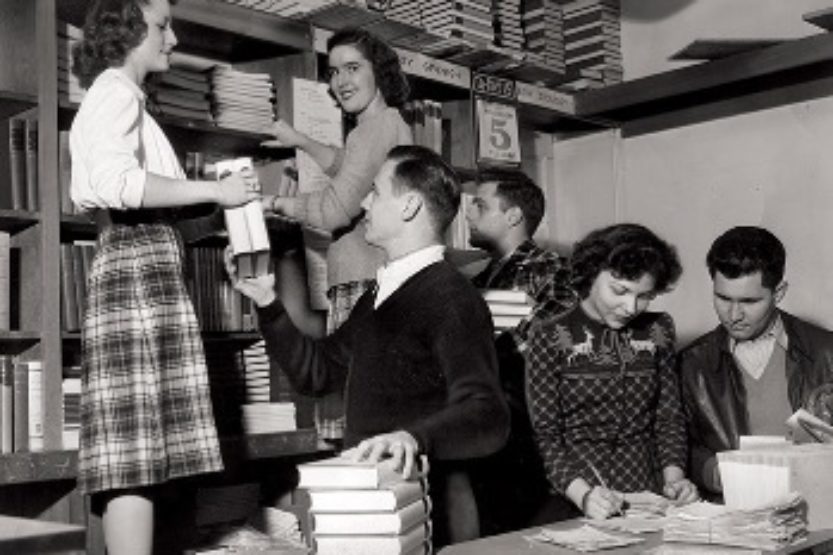Preparing for Peace
 Student veterans at bookstore
(UI Illinois Archives Photo)
Student veterans at bookstore
(UI Illinois Archives Photo) They piled in from Anzio, the Ardennes and the merciless deserts of Africa, from Midway Atoll and the sucking sands of Iwo Jima.
They came with their scars and their medals, high hopes and low bank accounts, some with spouses and children in tow, ready and eager to trade the battlefield for the halls of academia.
Buoyed by the educational support of the GI Bill, thousands of World War II veterans flocked to the University of Illinois in the 1940s, some of them arriving on a college campus for the first time, others returning to finish an interrupted education.
And the University welcomed them in a very special way.
Realizing that vets were an altogether different breed than typical undergraduates, the UI Board of Trustees approved the Division of Special Services for War Veterans (or DSSWV, as the major was dubbed) in 1944. The program—thought to be the first higher education venture of its kind—served as a sort of catchall for veterans’ needs, advising them and shepherding them to their bachelor’s degrees. The unit did so through both the regular degree process or by way of a customized, flexible curriculum, which could bypass prerequisites and credit life experiences to best suit the veterans’ goals. “We didn’t learn much from the last war,” said UI administrator E.E. Stafford in an Oct. 6, 1944,Daily Illini story about the program, “but we did learn how to treat the veteran.”
Robert Silverman ’50 DSSWV came to campus in 1948 to start his junior year at the age of 26. He, like many veterans, resided in Stadium Terrace housing which had been hastily thrown up on the parade ground unit north of Memorial Stadium. With DSSWV’s help, the former Army sergeant and military police officer, now 89, constructed an unusual curriculum that crossed two colleges, combining the creativity of advertising with the practicality of marketing. “The University relaxed a lot of rules,” the retired ad executive says, “and allowed many of us to do things like that.”
Navy veteran Constance Courtois Gillen ’48 DSSWV arrived in Urbana-Champaign as a newlywed in 1946. Living with her husband, Francis Gillen ’48 BUS, on the perimeter of campus in Quonset huts designated for married ex-military personnel and their families, she describes her housing as “very basic but very wonderful,” and was thrilled to be earning a college degree that she otherwise couldn’t have afforded.
“Oh, I remember the spirit of the campus—very warm and friendly,” the 90-year-old retired teacher says. Her memories include the inspiration she received from professors as well as the disapproval she felt from some students who felt a woman’s place was in the home.
Nearly 3,000 alumni, including 21 women, graduated from the DSSWV program over the course of two decades. They would go on to become CEOs, teachers, U.S. marshals, judges, priests, CPAs and engineers; their ranks include Broadway impresario Gerald Schoenfeld ’47 DSSWV, Playboy mogul Hugh Hefner ’49 DSSWV and Chicago real estate developer Lee Miglin ’51 MEDIA.
“Other universities might have had something similar,” Silverman says of the DSSWV effort, “but as I look back, I admire what the U of I did.”
Perhaps the University’s motivation can be inferred from the following passage in its 1946 Manual for War Veterans.
“Democracy, which can be saved from outside enemies by armed might,” it says, “can only maintain itself against its inner enemies by the intellectual strength of the citizenry.”

